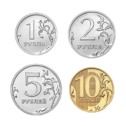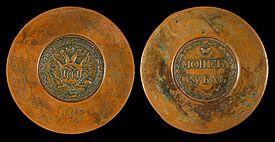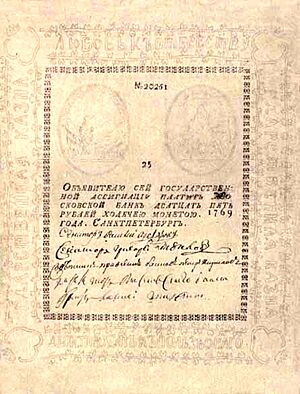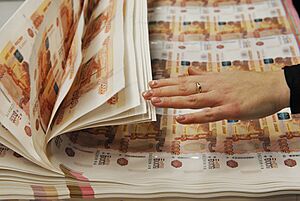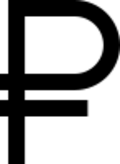Russian ruble facts for kids
Quick facts for kids Russian ruble |
|||||
|---|---|---|---|---|---|
|
|||||
| ISO 4217 Code | RUB | ||||
| User(s) | 1 leased territory
8 disputed territories
(2022–)
Multiple historical users
|
||||
| Inflation | 9.5% (December 2024) | ||||
| Source | Central Bank of Russia | ||||
| Method | CPI | ||||
| Subunit | |||||
| 1⁄100 | kopeyka (копейка), коп. or к | ||||
| Symbol | ₽ | ||||
| Plural | The language(s) of this currency belong(s) to the Slavic languages. There is more than one way to construct plural forms. See article. | ||||
| Coins | |||||
| Freq. used | ₽1, ₽2, ₽5, ₽10 | ||||
| Rarely used | 1 коп., 5 коп., 10 коп., 50 коп., ₽25 | ||||
| Banknotes | ₽5, ₽10, ₽50, ₽100, ₽200, ₽500, ₽1,000, ₽2,000, ₽5,000 | ||||
| Printer | Goznak | ||||
The ruble (symbol: ₽; ISO code: RUB) is the money used in the Russian Federation. The Central Bank of Russia prints the banknotes and makes the coins. This bank is in charge of Russia's money system.
The ruble is one of the oldest currencies still used today. It was also the first currency in the world to use a decimal system. This means it was divided into 100 smaller parts. The ruble was the money of the Russian Empire. Later, it was replaced by the Soviet ruble when the Soviet Union existed. After the Soviet Union broke up in 1991, Russia brought back the Russian ruble in 1992.
At one point, the ruble was the 17th most traded currency in the world. However, due to international rules and changes, it became the 34th most traded currency by April 2022. The ruble is divided into 100 kopecks. But kopecks are not used much anymore because their value is very low. In 2023, a new form of money, the digital ruble, was introduced.
History of the Ruble
How the Ruble Started
The ruble has been used in Russian lands since the 1300s. It is the second-oldest currency that is still in use today. Before coins, people in Russia used things like the grivna and ruble as ways to measure the weight of silver.
In 1704, Peter the Great made the ruble into a circulating coin. This happened just before the Russian Empire was formed. It was also the first currency in Europe to be divided into 100 smaller parts, called kopecks. This made it a "decimal" currency. Silver rubles were used until 1897, and gold rubles until 1917.
The Soviet ruble took over from the imperial ruble in 1922. It was used until 1993. Then, the Russian ruble came back in the Russian Federation. The ruble has changed its value and design many times. The current Russian ruble (RUB) was introduced in 1998. At that time, 1 new ruble was worth 1,000 old rubles.
What "Ruble" Means
The word "ruble" might come from the Russian word rubit, which means "to cut" or "to chop." Some people think this is because early rubles were pieces cut from a silver bar called a grivna.
Another idea is that the word comes from rubets, meaning "seam." This could refer to the seam left on silver bars after they were made.
The ruble was like the "mark" used in medieval Western Europe. Both were units of weight for silver and gold. In 1534, one Russian ruble was set to be worth 100 silver Novgorod denga coins. The Novgorod denga had a picture of a rider with a spear, which in Russian is kop’yo. This is where the word "kopeck" comes from.
In 1704, Peter the Great changed the money system. He ordered silver ruble coins to be made. Each was worth 100 new copper kopeck coins.
Early Russian Money
In medieval Russia, money was linked to how much things weighed. The grivna was the main money unit. But in the 1300s and 1400s, the ruble became the main way to count money. The first time the ruble was mentioned as a way to count money was in 1316.
In the late 1300s, Dmitry Donskoy made ruble coins and smaller coins called denga. The value of the ruble was different in various parts of the country. By 1535, one Novgorod denga weighed about 0.68 grams of silver. A Moscow denga was half of that. So, one ruble was worth 100 Novgorod denga or 200 Moscow denga.
In 1654, Tsar Alexis of Russia tried to change the money system. He made silver one-ruble coins and new copper kopeck coins. But these new rubles weighed less than the old ones. This caused problems like fake money and rising prices. After a big protest in 1662, the old money system was brought back.
Imperial Ruble (1704–1922)
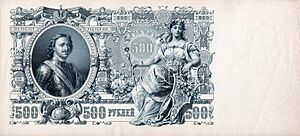
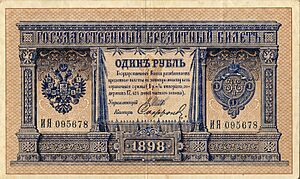
In 1704, Peter the Great successfully changed the Russian money system. He made a silver ruble coin that weighed about 28.1 grams. This ruble was divided into 100 copper kopecks, making it the world's first decimal currency.
The amount of silver in a ruble changed over the 1700s. Gold and platinum coins were also made. By the late 1700s, one ruble was set to be about 18 grams of pure silver. In 1828, platinum coins were introduced.
In 1885, a new rule was made. It kept the silver ruble the same but reduced the gold in gold coins. This linked the gold ruble to the French franc. In 1897, this link was changed again.
When World War I started, the ruble's value dropped a lot. It suffered from very high inflation in the early 1920s. When the Soviet Union was formed in 1922, the Russian ruble was replaced by the Soviet ruble.
Imperial Ruble Coins
By the early 1800s, copper coins were made for 1, 2, 4, and 5 kopecks. Silver coins were made for 5, 10, 25, 50 kopecks, and 1 ruble. Gold 5 ruble coins were also made. In 1820, silver 20 kopeck coins were added. Between 1828 and 1845, platinum coins for 3, 6, and 12 rubles were issued.
In 1886, new gold coins for 5 and 10 rubles were introduced. More gold coins followed in 1897. These included 7.5 and 15 ruble coins for one year. Gold coin production stopped in 1911. Other coins were made until World War I.
The Constantine ruble is a very rare silver coin from the Russian Empire. It shows the face of Grand Duke Constantine Pavlovich of Russia. These coins were planned in 1825 but were never widely made or used.
Imperial Ruble Banknotes
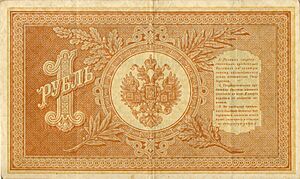
In 1768, during the time of Catherine the Great, the Russian Assignation Bank was created. It printed government paper money. In 1769, Assignation rubles were introduced for 25, 50, 75, and 100 rubles. Later, 5, 10, and 200 ruble notes were added. The value of these paper rubles dropped compared to coins. In 1839, it was set that 1 silver ruble was worth 3.5 assignat rubles.
In 1843, the Assignation Bank closed. New "state credit notes" were introduced for 1, 3, 5, 10, 25, 50, and 100 rubles. These notes were used until the revolution. Later, 500 ruble notes were added in 1898, and 250 and 1,000 ruble notes in 1917.
In 1917, the Russian Provisional Government printed notes for 20 and 40 rubles. These were known as "Kerenki" or "Kerensky rubles."
Soviet Ruble (1922–1992)
The Soviet ruble (code: SUR) replaced the Russian ruble between 1917 and 1922. It was the only money used in the Soviet Union until it broke up in 1991. After that, it was still used in 15 former Soviet countries. But by the end of 1992, these countries replaced it with their own new money. In Russia, the Russian ruble was brought back in 1992.
Russian Ruble (1992–1998)
After the Soviet Union ended in 1991, the Soviet ruble was still used in Russia until 1992. New coins were made in 1992, and new banknotes were issued in 1993 by the Bank of Russia. This new money replaced the Soviet ruble at the same value. Its international code was RUR.
The Russian ruble was also used in eleven other former Soviet countries between 1992 and 1993. This was called the "ruble zone." But by 1995, all these countries had switched to their own currencies.
The value of the ruble dropped a lot against the U.S. dollar during this time. In July 1992, 1 US dollar was worth 125 rubles. By 1998, it was about 6,000 rubles for 1 US dollar.
RUR Coins
After the Soviet Union fell, Russia made new coins in 1992. These were for 1, 5, 10, 20, 50, and 100 rubles. The coins showed a two-headed eagle without a crown. This eagle was the symbol of the Russian Republic.
Because of high inflation, the coins with the lowest values were not used much anymore. Other coins also became rare.
RUR Banknotes
In 1961, new State Treasury notes were made for 1, 3, and 5 rubles. New State Bank notes were made for 10, 25, 50, and 100 rubles. In 1991, the State Bank started making 1, 3, and 5 ruble notes. They also introduced 200, 500, and 1,000 ruble notes.
In 1992, the Russian Federation introduced 5,000 and 10,000 ruble notes. These were followed by 50,000 ruble notes in 1993, 100,000 rubles in 1995, and 500,000 rubles in 1997.
After the Soviet Union broke up, Russian banknotes and coins did not have portraits of people. This was different from earlier times. But later, the 500-ruble note showed a statue of Peter I of Russia, and the 1,000-ruble note showed a statue of Yaroslav I the Wise.
Russian Ruble (1998–Present)
In 1998, the Russian ruble was changed again. It got a new international code, "RUB." The exchange rate was 1 new RUB for 1,000 old RUR. This change made the old ruble easier to handle because it had so many zeros. This happened just before a financial crisis in Russia in 1998. The ruble lost 70% of its value against the US dollar in six months after this crisis.
From 2001 to 2013, the ruble stayed around 30 rubles for 1 US dollar. But from 2014 to 2021, its value dropped to about 60-80 rubles for 1 US dollar. This was due to events like the 2014 changes in Crimea and a drop in oil prices. After the 2022 events in Ukraine, it fell further to 110 rubles for 1 US dollar.
The ruble's value changed a lot in April 2022. It went back up to its value before the events in Ukraine. But from mid-2022 to mid-2023, it slowly dropped again, from 60 to 90 rubles per dollar.
In November 2024, the ruble fell below 100 rubles for 1 US dollar. By November 27, it was 114.5 rubles for 1 US dollar. The Bank of Russia stopped buying foreign currency from November 28 until the end of 2024 to try and make the currency more stable.
Ruble Symbol
A special symbol was used for the ruble from the 1500s to the 1700s. It looked like the Russian letters "Р" and "У" combined. This symbol was placed above the number. But it stopped being used by the mid-1800s.
For a long time, there was no official symbol. People used abbreviations like "Rbl" or "руб." In July 2007, the Central Bank of Russia said it would choose a new symbol.
On December 11, 2013, the official symbol for the ruble became ₽. It is a Cyrillic letter Er with a single horizontal line. This symbol was added to computer systems like Unicode in 2014.
Digital Ruble
In 2017, Russia started thinking about creating a "cryptoruble." By October 2020, the Central Bank of Russia talked about creating a Digital Currency of the Central Bank. This digital ruble would be issued by the Bank of Russia, making it safe. It would work like both cash and digital money. You could use it online or with an "offline wallet." One digital ruble would be worth one regular ruble.
In April 2021, the Central Bank decided on a plan. The Bank of Russia would manage digital wallets for banks, and banks would manage wallets for their customers. Testing of the digital ruble began on January 19, 2022. On February 15, 2022, the first digital ruble transfers between people were successful. They planned to test payments for goods and services next.
On August 15, 2023, the digital ruble was officially launched. In July 2023, a law was passed to make the digital ruble a legal form of money.
Coins
In 1998, new coins were introduced because the ruble's value changed. These coins are still used today.
| Image | Value | Technical parameters | Description | Years of minting | |||||
|---|---|---|---|---|---|---|---|---|---|
| Reverse | Obverse | Diameter | Mass | Composition | Edge | Obverse | Reverse | ||
| 1 kop | 15.5 mm | 1.5 g | Cupronickel-steel | Plain | Saint George | Value |
|
||
 |
 |
5 kop | 18.5 mm | 2.6 g | |||||
 |
 |
10 kop | 17.5 mm | 1.95 g | Brass | Reeded | Saint George | Value | 1997–2006 |
 |
 |
1.85 g | Brass-plated steel | Plain | 2006–2015 | ||||
 |
 |
50 kop | 19.5 mm | 2.90 g | Brass | Reeded | 1997–1999 2002–2006 |
||
 |
 |
2.75 g | Brass-plated steel | Plain | 2006–2015 | ||||
 |
 |
₽1 | 20.5 mm | 3.25 g | Cupronickel | Reeded | Emblem of the Bank of Russia | Value |
|
 |
 |
3.00 g | Nickel-plated steel | 2009–2015 | |||||
 |
 |
Coat of arms of Russia | 2016–present | ||||||
 |
 |
₽2 | 23 mm | 5.10 g | Cupronickel | Segmented (Plain and Reeded edges) | Emblem of the Bank of Russia |
|
|
 |
 |
5.00 g | Nickel-plated steel | 2009–2015 | |||||
 |
 |
Coat of arms of Russia | 2016–present | ||||||
 |
 |
₽5 | 25 mm | 6.45 g | Cupronickel-clad copper | Emblem of the Bank of Russia |
|
||
 |
 |
6.00 g | Nickel-plated steel | 2009–2015 | |||||
 |
 |
Coat of arms of Russia | 2016–present | ||||||
 |
 |
₽10 | 22 mm | 5.63 g | Brass-plated steel | Segmented (plain and reeded edges) | Emblem of the Bank of Russia | Value | 2009–2013, 2015 |
 |
 |
Coat of arms of Russia | 2016–present | ||||||
Kopeck coins are not used much because their value is so low. Some stores might not even accept them.
These coins were first made in 1998, but some have the year 1997 on them. Kopeck coins show Saint George and the Dragon. Ruble coins (except for special ones) show the two-headed eagle. Since 2000, many special 10 ruble coins have been made. These coins have a special security feature inside the "0" of the number 10.
In 2008, the Bank of Russia thought about stopping the use of 1 and 5 kopeck coins. They also thought about rounding all prices to the nearest 10 kopecks. This idea has not happened yet. The Bank of Russia stopped making 1 and 5 kopeck coins in 2012. They stopped making kopecks completely in 2018.
In 2009, a new 10 ruble coin was made from brass-plated steel. It has new security features. The 10 ruble banknote was supposed to be removed in 2012. But there weren't enough 10 ruble coins, so the Central Bank kept printing the notes. Special 25 ruble coins for the Olympics started in 2011. Many other special coins are made to celebrate national events.
Banknotes
On January 1, 1998, a new series of banknotes was released. These notes were dated 1997. They came in values of 5, 10, 50, 100, and 500 rubles. The 1,000 ruble banknote was first made on January 1, 2001. The 5,000 ruble banknote was first made on July 31, 2006. The designs of these notes were updated in 2001, 2004, and 2010.
In April 2016, the Central Bank of Russia announced two new banknotes for 200 and 2,000 rubles. These were released in 2017. The 200 ruble note shows symbols of Crimea, like the Monument to the Sunken Ships and views of Sevastopol and Chersonesus. The 2,000 ruble note shows images of the Russian Far East, like the bridge to Russky Island and the Vostochny Cosmodrome.
In 2018, the Central Bank made a special 100 ruble banknote. This note celebrated Russia hosting the 2018 FIFA World Cup soccer tournament. It is made of a special plastic material and has clear parts and a hologram. Even though it's real money, many ATMs in Russia cannot read or accept it.
In March 2021, the Central Bank said it would update the designs of the 10, 50, 100, 1,000, and 5,000 ruble banknotes. These new designs will have better security features. The first new design, for the 100 ruble note, was shown on June 30, 2022. This new note shows symbols of Moscow, like Red Square and the Bolshoi Theatre. It also shows the Rzhev Memorial to the Soviet Soldier. In late 2022, the Central Bank started printing 5 and 10 ruble notes again. These new notes began appearing in 2023.
| Image | Value | Dimensions | Description | Dates | |||||||
|---|---|---|---|---|---|---|---|---|---|---|---|
| Obverse | Reverse | Town | Obverse | Reverse | Watermark | Printing* | Issue | Withdrawal | Lapse | ||
 |
 |
[[Russian five-ruble banknote|₽5]] | 137 × 61 mm | Veliky Novgorod | The Millennium of Russia monument on background of Saint Sophia Cathedral | Fortress wall of the Novgorod Kremlin | "5", Saint Sophia Cathedral | 1997, 2022 | 1 January 1998 | Current, but not issued from 2001 until 2021. Re-issued in 2022. Rarely seen in circulation. Returned to circulation in 2023. | |
 |
 |
[[Russian ten-ruble banknote|₽10]] | 150 × 65 mm | Krasnoyarsk | Kommunalny Bridge across the Yenisei River, Paraskeva Pyatnitsa Chapel | Krasnoyarsk hydroelectric plant | "10", Paraskeva Pyatnitsa Chapel |
|
Current, but not issued from 2010 to 2021. Re-issued in 2022. Still in use, but rarely seen in circulation. Returned to circulation in 2023. | ||
 |
 |
₽50 | Saint Petersburg | A Rostral Column sculpture on background of Peter and Paul Fortress | Old Saint Petersburg Stock Exchange and Rostral Columns | "50", Peter and Paul Cathedral | Current | ||||
 |
 |
₽100 | Moscow | Quadriga statue on the portico of the Bolshoi Theatre | The Bolshoi Theatre | "100", The Bolshoi Theatre | |||||
 |
 |
₽500 | Arkhangelsk | Monument to Czar Peter the Great, sailing ship and sea terminal | Solovetsky Monastery | "500", portrait of Peter the Great |
|
||||
 |
 |
₽1,000 | 157 × 69 mm | Yaroslavl | Monument to Yaroslav I the Wise and the Lady of Kazan Chapel | John the Baptist Church | "1,000", portrait of Yaroslav the Wise |
|
1 January 2001 | ||
 |
 |
₽5,000 | Khabarovsk | Monument to Nikolay Muravyov-Amursky | Khabarovsk Bridge over the Amur | "5,000", portrait of Muravyov-Amursky |
|
31 July 2006 | |||
These images are to scale at 0.7 pixel per millimetre. For table standards, see the banknote specification table.
|
|||||||||||
| Image | Value | Dimensions | Description | Date of | ||||||
|---|---|---|---|---|---|---|---|---|---|---|
| Obverse | Reverse | Federal District | Obverse | Reverse | Watermark | Printing | Issue | Withdrawal | ||
| ₽10 | 150 × 65 mm | Siberian Federal District | Novosibirsk | "10" | 2025 | Current | ||||
| ₽50 | Northwestern Federal District | Saint Petersburg | "50" | |||||||
 |
 |
₽100 | Central Federal District | Moscow: Spasskaya Tower, Zaryadye Park, Moscow State University, Ostankino Tower | Memorial to the Soviet Soldier, Rzhev, Tver Oblast; Kulikovo Field, Tula Oblast | "100", Spasskaya Tower | 2022 | 30 June 2022 | ||
 |
 |
₽200 | Southern Federal District | Monument to the Sunken Ships (by sculptor Amandus Adamson), Sevastopol | View of Chersonesus | "200", Monument to the Sunken Ships | 2017 | 12 October 2017 | ||
| ₽500 | North Caucasian Federal District | Pyatigorsk | "500" | 2025 | ||||||
 |
 |
₽1,000 | 157 × 69 mm | Volga Federal District | Nizhny Novgorod: Nikolskaya Tower of the Nizhny Novgorod Kremlin, Nizhny Novgorod Fair, Spit of Nizhny Novgorod, Nizhny Novgorod Stadium | Museum of the History of Statehood of the Tatar People and the Republic of Tatarstan in Kazan, Söyembikä Tower on the Kazan Kremlin, Museum of Archeology and Ethnography in Ufa | "1000", Nikolskaya Tower of the Nizhny Novgorod Kremlin | 2023 | 16 October 2023 | |
 |
 |
₽2,000 | Far Eastern Federal District | Vladivostok: Russky Bridge, Far Eastern Federal University | Vostochny Cosmodrome, Tsiolkovsky, Amur Oblast | "2000", Russky Bridge | 2017 | 12 October 2017 | ||
 |
 |
₽5,000 | Ural Federal District | Yekaterinburg: Stele "Europe – Asia", Iset Tower in Yekaterinburg-City, Vysotsky, Yekaterinburg Circus, House of Communications (main post office building), Palace of Sporting Games, Sevastyanov's House | Monument "Tale of the Urals" in Chelyabinsk, metallurgical plant, stele "66 parallel" (Arctic Circle) in Salekhard, oil and gas industry facilities | "5000", House of Communications (main post office building), Sevastyanov's House | 2023 | 16 October 2023 | ||
For the rest of the 2017–2025 series, the following designs are planned:
- ₽10 (2025): Novosibirsk on the front, Siberian Federal District on the back
- ₽50 (2025): Saint Petersburg on the front, Northwestern Federal District on the back
- ₽500 (2025): Pyatigorsk on the front, North Caucasian Federal District on the back.
Printing Money

All Russian ruble banknotes are printed at a government-owned factory called Goznak in Moscow. This factory started on June 6, 1919. Coins are made at the Moscow Mint and the Saint Petersburg Mint. The Saint Petersburg Mint has been making coins since 1724.
Banknote Controversies
1,000 Ruble Note Controversy
On October 16, 2023, a new 1,000 ruble note was shown. Some people from the Russian Orthodox Church were unhappy with its design. They said it showed an Islamic symbol on one building but removed an Orthodox cross from another building that used to be a church. The Bank of Russia announced the next day that they would change the design and not print these notes.
Effects of International Changes
Some reports said that the new 100 ruble note from 2022 might not work with many cash registers and ATMs. This is because these machines are often imported and need updates from foreign companies. However, Russian banks have been changing their ATM systems to use local software since 2018. The largest Russian bank, Sberbank, had already made 80% of this change by June 2022. Russian banks plan to buy ATMs made in Russia starting in 2023.
Special Banknotes
| Image | Value | Dimensions | Description | Dates | |||||||
|---|---|---|---|---|---|---|---|---|---|---|---|
| Obverse | Reverse | Obverse | Reverse | Watermark | Printing* | Issue | Withdrawal | Lapse | |||
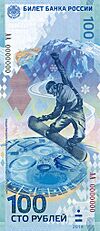 |
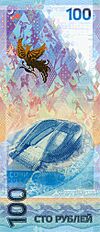 |
₽100 | 150 × 65 mm | A snowboarder and some of the Olympic venues of the Sochi coastal cluster. | Fisht Olympic Stadium in Sochi, firebird | 2014 Winter Olympics logo | 2014 | 30 October 2013 | Current | ||
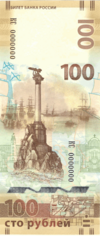 |
 |
Monument to the Sunken Ships in Sevastopol Bay, outlines of Monument to the heroes of the Second Siege of Sevastopol and St. Vladimir Cathedral, fragment of a painting by Ivan Aivazovsky | Swallow's Nest castle, Yevpatoria RT-70 radio telescope, outline of Big Khan Mosque in Bakhchisaray and a green stripe containing a QR code linking to the Bank of Russia webpage containing historical information relating to the commemorative banknote | Portrait of Empress Catherine the Great | 2015 | 23 December 2015 | |||||
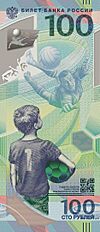 |
 |
A boy with a ball under his arm looking up as Lev Yashin saves a ball. | A stylized image of the globe in the form of a football with a green image of Russia's territory (including Crimea) outlined on it, as well as the name of the 2018 FIFA World Cup host cities | The number 2018 | 2018 | 22 May 2018 | |||||
On October 30, 2013, a special banknote was made to celebrate the 2014 Winter Olympics in Sochi. It shows a snowboarder and Olympic buildings. The back shows the Fisht Olympic Stadium.
On December 23, 2015, another special 100 ruble banknote was made. This one celebrated the "reunification of Crimea and Russia." One side shows Sevastopol, and the other shows Crimea. It has a QR code that links to information about the banknote.
On May 22, 2018, a special banknote was made for the 2018 FIFA World Cup. It is made of plastic. The front shows a boy with a ball and a goalkeeper. The back shows a globe shaped like a football with Russia's territory outlined. It also lists the host cities for the World Cup.
Economics of the Ruble

In Russia, it is usually against the law to use other countries' money for payments between Russian people. There are only a few exceptions. If you break this rule, you can be fined a large part of the transaction's value.
International Trade
In November 2010, Russia and China decided to use their own money for trade instead of the US dollar. This was to improve their relationship and protect their economies. Trading of the Chinese yuan against the ruble started in China.
In January 2014, President Putin said that the ruble's exchange rate should be balanced. He said the Central Bank only stepped in if the rate went too high or too low. He believed that a freer Russian currency would help the economy react better to changes. The Russian ruble is one of the few currencies in the world that can "float freely," meaning its value is mostly set by the market.
Changes in international relations have affected the ruble's value. These changes have also impacted Russia's economy. For example, in 2014, Russia's finance minister said that certain international actions cost Russia $40 billion. Another $100 billion was lost that year because oil prices dropped.
In early 2022, Russia faced more economic changes. This caused the ruble's value to drop by 32% against the U.S. dollar. It went as low as 119 rubles for 1 US dollar in February 2022. The Russian central bank raised interest rates to 20% to help. They also temporarily closed the Moscow Stock Exchange. They made Russian companies sell most of their foreign money. They also stopped foreigners from selling their assets in Russia.
By March 2022, the ruble started to recover. This was partly because of high demand for gas and oil from other countries. It was also due to economic steps taken to support the currency. By June 2022, the ruble reached its highest value in seven years.
In early November 2023, the ruble's value went up a little. It reached 90 rubles against the US dollar, which was its highest in three months. Russia's main interest rate went up to 15% in October. Rules that made Russian companies sell foreign money also helped the ruble's value. The overall drop in the ruble's value is a big problem for Russia's economy. It makes prices go up, especially for goods brought in from other countries.
Exchange Rates
| Year | Lowest ↓ | Highest ↑ | Average | |||||
|---|---|---|---|---|---|---|---|---|
| Date | Rate | Date | Rate | Rate | ||||
| 1998 | 1 January | 5.9600 | 29 December | 20.9900 | 9.7945 | |||
| 1999 | 1 January | 20.6500 | 29 December | 27.0000 | 24.6489 | |||
| 2000 | 6 January | 26.9000 | 23 February | 28.8700 | 28.1287 | |||
| 2001 | 4 January | 28.1600 | 18 December | 30.3000 | 29.1753 | |||
| 2002 | 1 January | 30.1372 | 7 December | 31.8600 | 31.3608 | |||
| 2003 | 20 December | 29.2450 | 9 January | 31.8846 | 30.6719 | |||
| 2004 | 30 December | 27.7487 | 1 January | 29.4545 | 28.8080 | |||
| 2005 | 18 March | 27.4611 | 6 December | 28.9978 | 28.1910 | |||
| 2006 | 6 December | 26.1840 | 12 January | 28.4834 | 27.1355 | |||
| 2007 | 24 November | 24.2649 | 13 January | 26.5770 | 25.5808 | |||
| 2008 | 16 July | 23.1255 | 31 December | 29.3804 | 24.8529 | |||
| 2009 | 13 November | 28.6701 | 19 February | 36.4267 | 31.7403 | |||
| 2010 | 16 April | 28.9310 | 8 June | 31.7798 | 30.3679 | |||
| 2011 | 6 May | 27.2625 | 5 October | 32.6799 | 29.3823 | |||
| 2012 | 28 March | 28.9468 | 5 June | 34.0395 | 31.0661 | |||
| 2013 | 5 February | 29.9251 | 5 September | 33.4656 | 31.9063 | |||
| 2014 | 1 January | 32.6587 | 18 December | 67.7851 | 38.6025 | |||
| 2015 | 17 April | 49.6749 | 31 December | 72.8827 | 61.3400 | |||
| 2016 | 30 December | 60.2730 | 22 January | 83.5913 | 66.8336 | |||
| 2017 | 26 April | 55.8453 | 4 August | 60.7503 | 58.2982 | |||
| 2018 | 28 February | 55.6717 | 12 September | 69.9744 | 62.9502 | |||
| 2019 | 26 December | 61.7164 | 15 January | 67.1920 | 64.6184 | |||
| 2020 | 10 January | 61.0548 | 18 March | 80.8692 | 72.4388 | |||
| 2021 | 27 October | 69.5526 | 8 April | 77.7730 | 73.6628 | |||
| 2022 | 30 June | 51.1580 | 11 March | 120.3785 | 68.4869 | |||
| 2023 | 15 January | 66.0026 | 8 October | 101.0001 | 85.5086 | |||
| 2024 | 20 June | 82.6282 | 29 November | 109.5782 | 92.6567 | |||
| Source: USD exchange rates in RUB, Bank of Russia | ||||||||
| Current RUB exchange rates | |
|---|---|
| From Google Finance: | AUD CAD CHF EUR GBP HKD JPY USD |
| From Yahoo! Finance: | AUD CAD CHF EUR GBP HKD JPY USD |
| From XE.com: | AUD CAD CHF EUR GBP HKD JPY USD |
| From OANDA: | AUD CAD CHF EUR GBP HKD JPY USD |
| From fxtop.com: | AUD CAD CHF EUR GBP HKD JPY USD |
The first Russian ruble (RUR) was introduced in January 1992. Its value dropped a lot against the US dollar. It went from 125 RUR for 1 US dollar to about 6,000 RUR (or 6 RUB) when it was redenominated in January 1998. The new ruble then quickly dropped to 20 RUB for 1 US dollar. But it became stable around 30 RUB for 1 US dollar from 2001 to 2013.
A financial crisis in Russia from 2014 to 2016 happened because the ruble's value fell. People lost trust in the Russian economy. This made investors sell their Russian assets, which caused the ruble's value to drop even more. This lack of trust came from two main things. First, the price of oil fell by almost 50% in 2014. Oil is a major export for Russia. Second, international economic actions were taken against Russia.
The crisis affected Russian people and businesses. It also impacted financial markets. The Russian stock market saw big drops. From July 2014 to February 2015, the ruble fell sharply against the US dollar. Even when interest rates were raised, it didn't stop the currency from hitting very low points. This was due to low oil prices and international actions.
Russia faced more economic changes in early 2022. This was due to events in Ukraine. Many countries took strong economic actions against Russia. This caused the ruble's value to drop by 32%. In March 2022, it was trading at 120 rubles for 1 US dollar.
On March 23, 2022, President Putin announced that Russia would only accept payments for its gas from certain countries in rubles. This, along with other steps to control money flow, helped the ruble's value go up. By May 2022, the ruble reached a record high. It continued to rise in June 2022, reaching its highest point in seven years.
In early November 2023, the ruble's value increased slightly. It reached a three-month high of 90 against the US dollar. Russia's main interest rate went up to 15% in October. Rules that made Russian companies sell foreign money also helped the currency. The overall drop in the ruble's value is a big problem for Russia's economy. It makes prices go up, especially for goods brought in from other countries.
See also
 In Spanish: Rublo ruso para niños
In Spanish: Rublo ruso para niños



